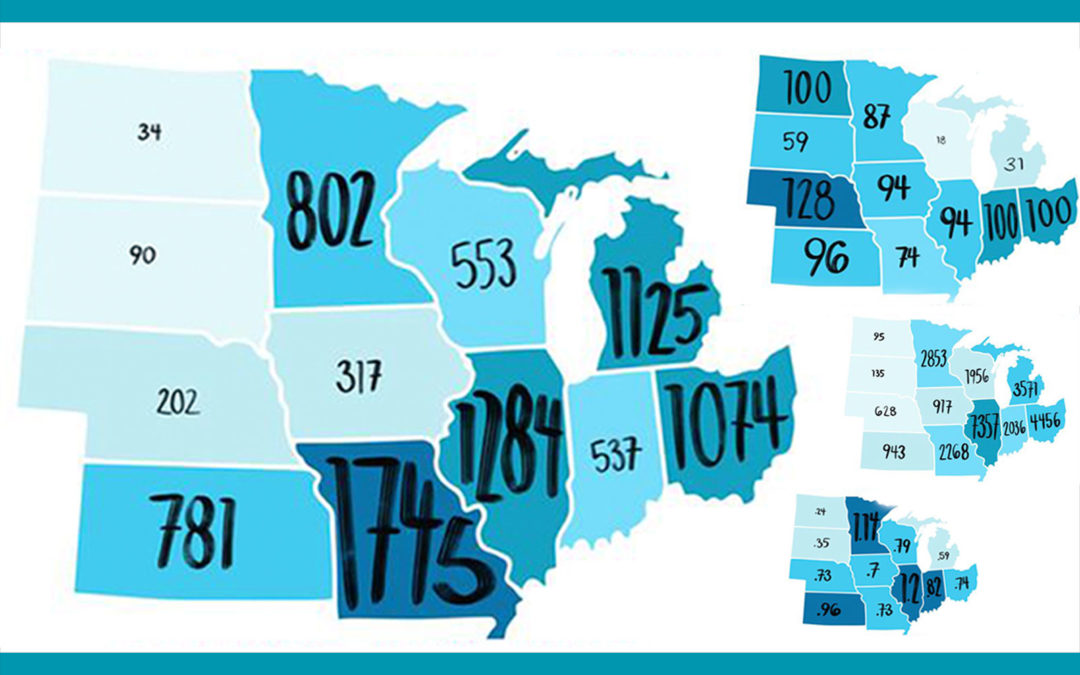
by Jane McCurry | Jul 31, 2019 | Electric Vehicles
I’ve been following the NRDC Fellows’ EV road trip across the Midwest. They drove, they charged, and they wrote about it. This particular blog post, about the Midwest electric vehicle market, caught my eye. At first, maybe it was due to the colorful maps, but I found an underlying message for Wisconsin in this post: Keep the ball rolling.
There is so much potential for Wisconsin to be a leader in the electric vehicle market, and these statistics prove it. With hardly any pro-electric vehicle policy, Wisconsin is keeping up with states like Minnesota and Michigan. Think about what we could do if we keep the ball rolling! Recent wins like the Volkswagen Settlement Funding signal a bright future for Wisconsin’s electric vehicle market.
Enjoy!
July 02, 2019
Ada Statler Jessica Russo Madhur Boloor Patricia Valderrama Samuel Garcia
This is the sixth blog in a series about our Midwest electric vehicle adventure.
We’ve written about electric vehicle (EV) policies and pilot programs in the Midwest, as well as sub-trends we’ve seen along our 1,300+ mile electric road trip route. But it can also be helpful to see where the numbers stand overall. These maps look state by state at EV sales numbers, market shares, growth, charging infrastructure, and related jobs. Notably, the places where we’re seeing the most EV-related activity (darker blues in the map) are also generally where we’ve seen the introduction of more EV-friendly policies.
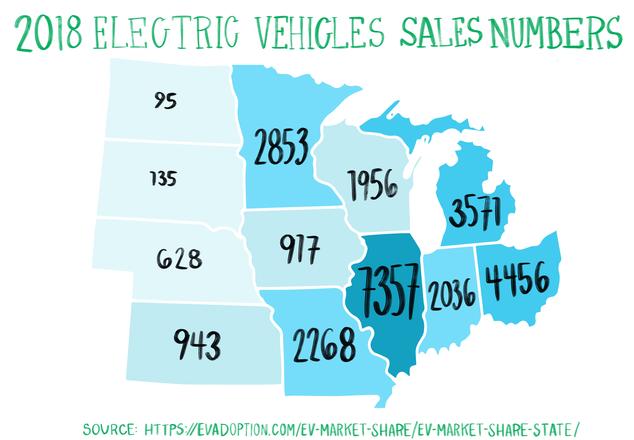
Looking at the number of new EVs bought in a state can seem like the most straightforward way to understand how many clean cars are on the road there. But without taking population and car ownership numbers overall into account, it is hard to really get a sense of where EVs are taking off and where they still need encouragement.
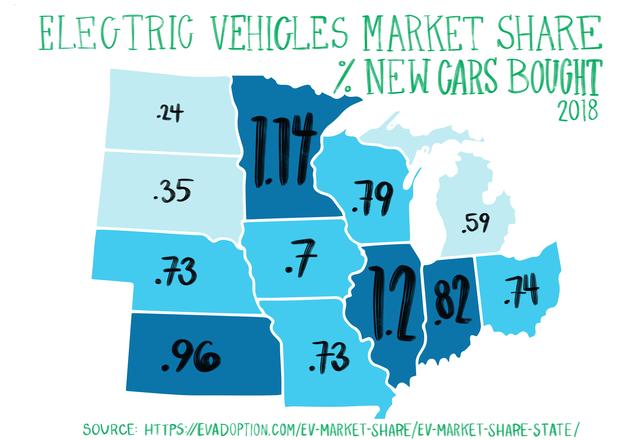
Looking at EV purchases as a percent of market share within each state is a bit more helpful as it allows you to consider how big of a presence EV sales are in the state’s market. For perspective, the highest EV penetration is in states like California, where the 7.84 percent EV market share of new vehicles bought in the state in 2018 represents 46.8% of national EV sales that year—likely due to Zero Emissions Vehicles (ZEV) Standards that require automakers to stock EVs in-state. The ZEV standard goal is 2.5 percent market share for EVs by 2025 and 8 percent market share by 2030. No Midwestern states have joined the coalition of states with ZEV standards. Nevertheless, Illinois and Minnesota lead the region with 1.2 and 1.14 percent EV market shares respectively. (It’s no coincidence that both these states also have a relatively high number of public chargers, and that Minnesota has been moving forward with utility charging programs.) Policies like ZEV standards could go a long way toward reducing barriers to EV access in this region and expanding consumer choice.
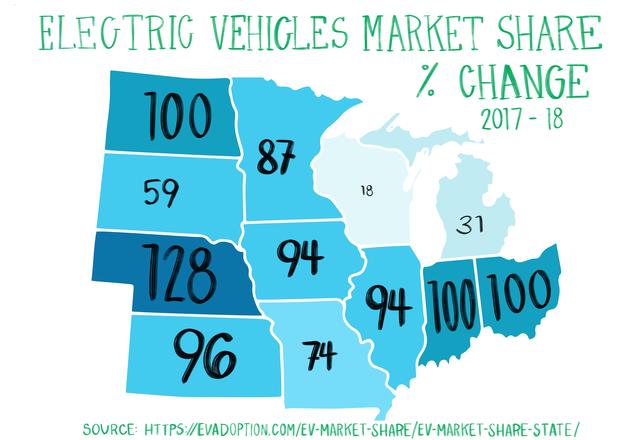
It might still be hard to get a sense of EV growth without looking at how the market share changes from year to year. The short of it: quickly! This map shows the change in EV market share over one year. Notably, some states, like Illinois, have grown faster (as a percent change) in the past, while others, like Nebraska, are just starting to see more growth and thus appear to have greater growth.
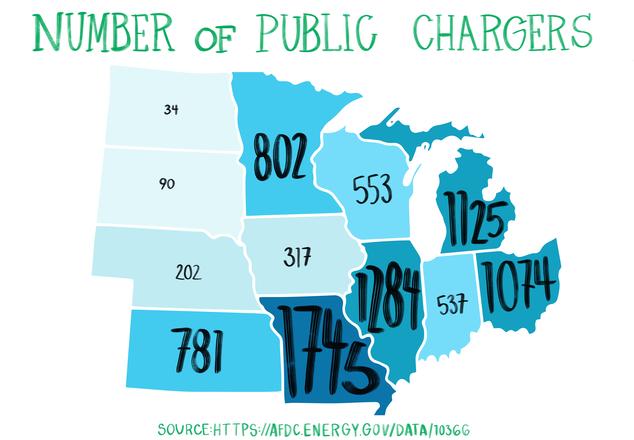
Increasing the number of public charging stations is essential in order to enable longer-distance travel in electric vehicles and ownership options for roadtrippers, and for those who may not be able to charge an EV at home. This data source looks at number of plugs as opposed to stations because there may be anywhere from one to eight plugs at a single charging station. Both the total plug count and the total station count are important: we don’t want any EVs to have to wait in line to charge, but we also want to make sure that stations have a useful geographic spread.
It’s important to note that these ports are not evenly distributed throughout the state. Most are concentrated in larger cities, with a few along major highways. In our experience, there are certainly spots where more could be useful. For instance, even in Missouri, which has the largest number of absolute charging ports in the region, it would have been very difficult for us to travel in our Chevy Bolt (a longer range non-Tesla EV) between the state’s two largest cities, St. Louis and Kansas City. This is just one example of the need for more strategically distributed chargers.
Thanks to the NRDC team for allowing us to share their blog. Check out other blogs from the NRDC Fellows Road Trip here.
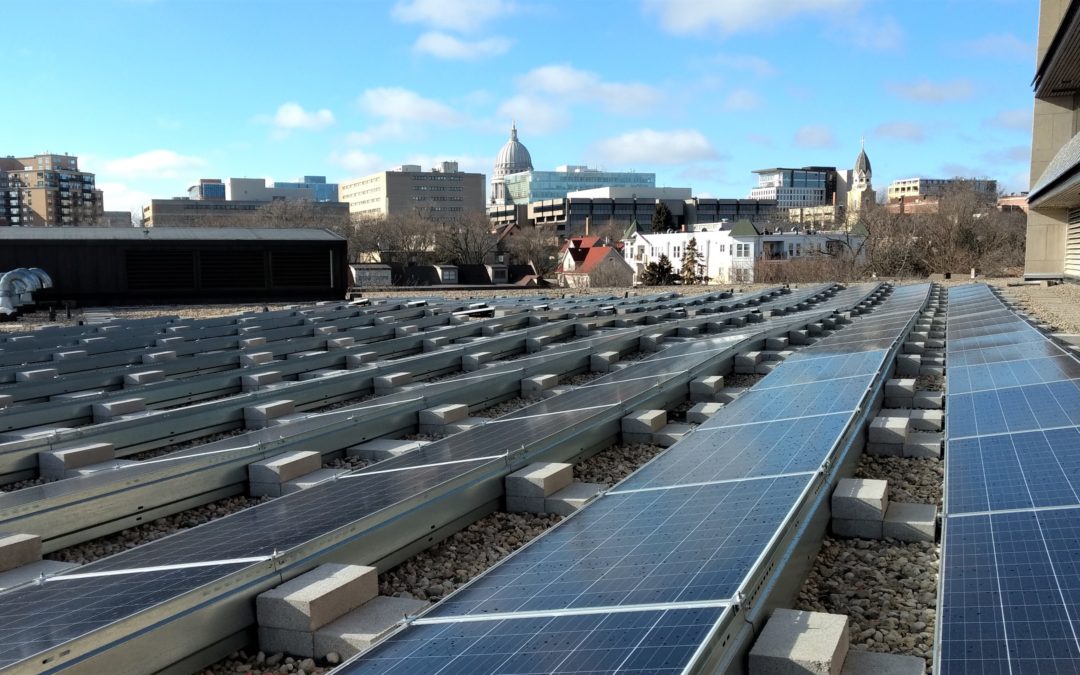
by Michael Vickerman | Jul 25, 2019 | PSC Priorities, Public Service Commission, Utilities
Today the Public Service Commission of Wisconsin approved two long-term supply contracts between Madison Gas and Electric (MGE) and two of its customers who wish to receive more electricity from renewable energy.
With these approvals in hand, the City of Middleton and the Middleton-Cross Plains Area School District become the first customers in Wisconsin to contract with their local utility to receive emission-free electricity from an offsite solar plant.
Together, these customers have committed to receive the output from 1.5 megawatts (MW) of solar power that MGE will build on property owned by the City of Middleton near its municipal airport. The school district’s commitment amounts to 1 MW, while the city’s commitment is for 500 kilowatts. The solar project itself will total 5 MW, with the other 3.5 MW approved earlier this summer as an expansion of MGE’s Shared Solar program.
Under MGE’s Renewable Energy Rider service, larger customers with multiple facilities, such as local governments, school districts, and companies, can source some of the electricity they use from a nearby dedicated solar plant. This voluntary service enables customers to drive the expansion of renewable power and directly benefit from the additional solar capacity beyond the amount of solar power that their own buildings could hold.
After MGE became the first Wisconsin utility to gain approval in 2017 to create their 25 MW program, We Energies and Alliant Energy sought and received approval for 150 MW each in similar programs for customers they serve.
“Today’s approval of these innovative contracts between MGE, City of Middleton, and Middleton-Cross Plains Area School District moves Wisconsin forward to more homegrown, healthy, and smart renewable energy. This approval blazes a path that state government, local governments, and companies all across Wisconsin can follow to voluntarily increase their renewable energy usage in a cost-effective manner,” said RENEW Executive Director Tyler Huebner.
“These 1.5 megawatts of solar power should be just the beginning as MGE, We Energies, and Alliant Energy have a combined authority to subscribe up to approximately 325 megawatts of renewable energy under their programs.”
Early Support from RENEW
RENEW supported the creation of MGE’s program in our 2017 Public Comments, which included this statement: “There is significant and growing corporate interest in increasing consumption of renewable energy. In addition, there is growing interest among institutional customers such as municipalities, school districts, and technical colleges to access renewable energy, and along with corporate customers, these entities tend to view their utility as their trusted long-term partner on energy. As these customers weigh their options for accessing renewable energy, we believe it is important that our regulated utilities are granted flexibility to pursue tariffs and contracts to meet those needs.”
MGE serves four municipalities–Middleton, Madison, Monona and Fitchburg–that have recently adopted 100% renewable energy goals. The approved contracts clear a path for these communities and other entities with ambitious clean energy goals to access more solar power under this model.
Shared Solar Expansion Underway
The solar facility to be built will be a total of 5 megawatts, of which 3.5 megawatts will be dedicated to MGE’s Shared Solar program. Earlier this summer, MGE received approval from the PSC to revise and expand its shared solar service. MGE now offers shared solar subscriptions to smaller commercial customers (including nonprofits) as well as to residential customers.
The larger array provides solar power at a lower cost, which allows MGE to substantially narrow the cost differential between MGE’s shared solar service and its standard rates. The array should produce 9.2 million kilowatt-hours in its first full year of operation, enough electricity to cover the needs of about 1,182 average Wisconsin homes.
OneEnergy Renewables, a Seattle-based company whose Midwest office operates out of Madison, originally developed the 16-acre site at Morey Field (Middleton’s airport) where MGE’s solar array will be constructed. OneEnergy also recently developed a portfolio of solar arrays in western Wisconsin that supply electricity to seven different municipalities while providing renewable energy credits under long-term contracts to Organic Valley and the City of Madison.
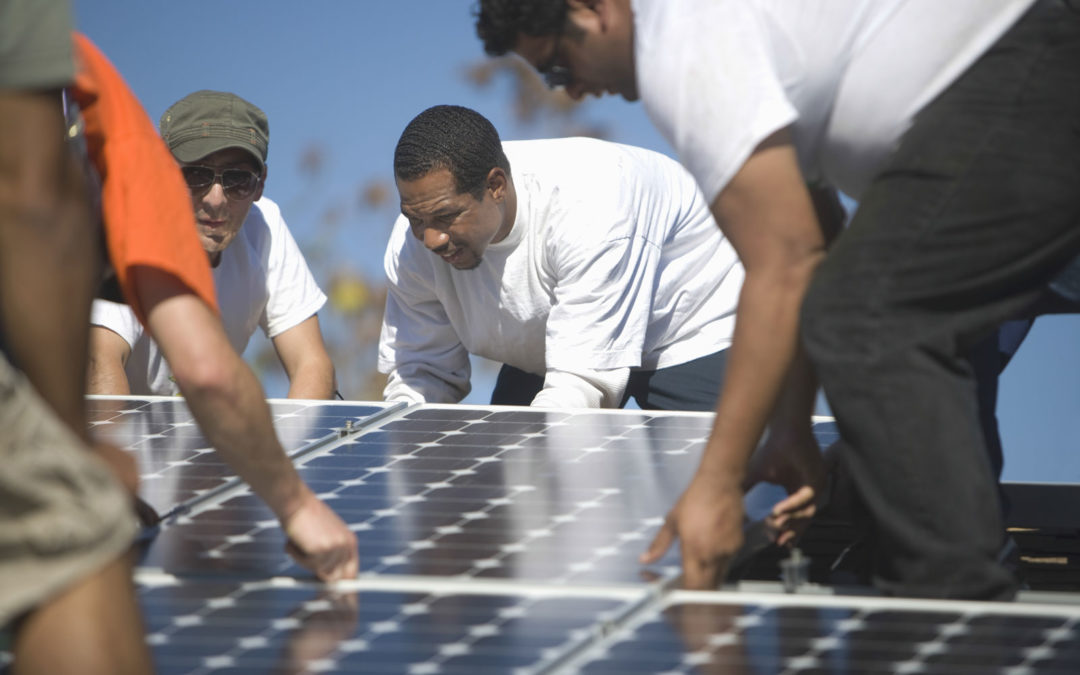
by Tyler Huebner | Jul 15, 2019 | RENEW Wisconsin, Renewables, Solar, Utilities
We Energies and RENEW Wisconsin are pleased to announce a settlement agreement with two important provisions regarding solar energy and customer-owned generation.
With the agreement, We Energies will no longer pursue a solar fixed-cost recovery charge as part of its rate review with the Public Service Commission of Wisconsin, and RENEW Wisconsin agrees to support an upcoming We Energies utility-scale solar project.
The two parties also agree to collaborate in a series of good-faith discussions for at least the next two years with the goal of finding potential areas of agreement on renewable energy and distributed generation as We Energies continues the transition to a clean energy future.
by Heather Allen | Jul 8, 2019 | Local Initiatives, Renewables, Solar, Sustainability
In November 2018 voters approved a $57 million referendum to build a new school and make improvements in the Monona Grove School District. As Monona Grove designs and plans a new 615-student elementary school, local residents are working to ensure the building includes renewable energy and sustainable design. You can follow the elementary school construction design process here. While there has been discussion of a 100% renewable energy resolution, this has not been formerly introduced to the Monona Grove School Board yet.
In June I had the pleasure of attending the Monona Grove School Board meeting and hearing from a number of clean energy supporters. Science teacher Tyler Keuhl made particularly thoughtful comments which I asked him to share with us. The following are excerpts from his remarks.
 Hello Everyone!
Hello Everyone!
My name is Tyler Kuehl and I am a science teacher at the high school. Thank you for the opportunity to speak tonight. Tonight I’d like to speak from a Monona Grove teacher perspective encouraging the district to adopt a 100% renewable energy resolution.
I’ve taught environmental science at Monona Grove High School for the past 7 years. One thing those of us who operate in educational circles have come to know quite well, is that learning is a two way street. When we get into education we hope that we can have a lifelong impact on our students, and we soon realize that our students teach us a great deal, as well. While I hope my former students have learned things about science and themselves, I know that I’ve learned a great deal from them. They care about a sustainable future and have taught me how important that is to them.
One of the themes in my curriculum comes from a quote that drives a lot of different things in my life. Edmund Burke said, “No man made a greater mistake than he who did nothing because he could only do a little.” I tell students that their own individual actions are vital even while they may seem small. In essence, I want my students to dream big, but not ignore the seemingly small daily opportunities they have to make a difference. In all honesty though, I don’t think adopting this resolution should even be seen as “dreaming big.” This is an action that has been taken by large cities and entire countries. It’s time for us to play our small part.
I get very similar feedback from every group of students at the end of each year; that environmental science should be a required course. I agree in a sense. The significance of these problems necessitates the education of all who walk through the doors of Monona Grove School District buildings. However, I don’t think you accomplish that by making environmental science a required course. I think you accomplish that by becoming a sustainable district.
Students should be interacting with concepts that encourage a sustainable future throughout their educational career. We need to teach students the history of how we got to where we are, the energy solutions, economic models and strategies, the psychology of changing behavior, and that there are social justice and career opportunities for every student in a society that must increasingly embrace sustainability. I think ultimately this is a curricular outcome of a district who takes steps to be sustainable itself.
Now the really cool thing about our district is that this is already happening organically. Students are learning some of these things and are taking action as individuals. It’s time for us to once again learn from them and follow their lead.
As a part of a project that I do in my class where I give the kids space and time to try and make an impact, they’ve done some great things for our school and community. They’ve raised funds to build two fresh water wells for schools in Uganda and reusable water bottle refilling stations at the high school. They’ve saved countless rolls of paper towels by doing the legwork to get electric hand dryers installed in first level bathrooms, which also saved the school thousands of dollars. They’ve created educational programing for elementary students to teach them about freshwater usage and plastic pollution. They’ve been leading the way on these things. As the adults in a district that’s mission is to, “enhance achievement for all students by cultivating a desire for learning and instilling a social responsibility” we must not squander this opportunity. It is beyond the time for our own social responsibility to kick in.
The old adage from Theodore Roosevelt, which rings true in so many ways inside education, echoes here as well. Students won’t care how much we know, until we show them how much we care. They know we know that climate change is a serious issue. But we as the adults in this district need to show them we care by adopting a 100% renewable energy resolution.
Thank you.
Thanks to Tyler for sharing his comments with the RENEW community! We will stay tuned as Monona Grove explores its renewable energy options.

by Jane McCurry | Jul 3, 2019 | Electric Vehicles
Wisconsin has secured Volkswagen Settlement funding for electric vehicle charging stations!
Governor Evers signed the State Budget today, with 78 partial vetoes. One of those vetoes was used to edit the section designating Volkswagen Settlement funding. In the signed budget, up to $10 million can be used for electric vehicle charging stations.
Over the next two years, Wisconsin is expected to receive $25 million in Volkswagen settlement funding. Evers’ veto reinstates his original proposal which allocates $15 million to replace public buses and up to $10 million for electric vehicle charging stations.
Together, we sent 443 letters to legislators telling them that electric vehicle charging stations are important for advancing clean energy in Wisconsin. Thank you for your support in making this issue heard!
Now, Wisconsin will join the 45 other states taking advantage of this huge opportunity to kickstart the fast-growing electric market. We are eager to see the future of clean transportation in Wisconsin, and believe this funding will go a long way toward making electric vehicles accessible for all Wisconsinites.









